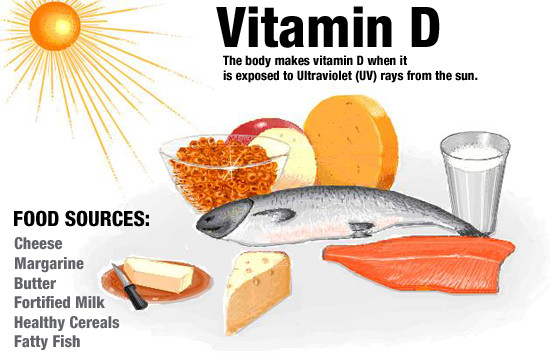Vitamin D is required for the absorption of calcium by the human body to maintain remodeling of bones, but excess intake of vitamin D can increase the risk of toxicities and health issues. Abnormally high levels of calcium are reported in the setting of vitamin D toxicity that may significantly affect the metabolism of bones and tissues. In poorly addressed or untreated situations, the risk of several health issues increases such as development of high blood pressure and renal damage.
Vitamin D is also obtained from the sunlight as a result of de-novo synthesis.However, it is imperative to keep in mind that too much exposure to sunlight does not cause the toxicity. In most cases, it has been observed that the primary cause of toxicity is high intake of vitamin D supplements. The primary treatment regimen for the vitamin D toxicity is tapering off the dose of vitamin D supplements as well as reduction of calcium-rich foods from the daily diet. Careful monitoring is needed in the patients who are suffering from vitamin D toxicity until the levels reach to basal concentration.
What Are the Symptoms of Vitamin D Overdose?
Vitamin D toxicity usually presents as an increase in the concentration of calcium in the blood, the characteristic symptoms include:
- Excessive weight loss
- Polydipsia (increased thirst)
- Increased frequency of urination
- Gastrointestinal problems (constipation, vomiting and nausea)
- Skeletal muscle problems (fatigue and muscle pain)
- Central nervous system problems (confusion, nervousness)
- Cardiovascular problems (irregular heartbeats also called as arrhythmias and increased blood pressure)
If not treated properly, then chronic symptoms may appear which includes typical systemic toxicities such as:
- Kidney failure
- Kidney stones
- Serious kidney damage
- Hardening of vessels (deposition of calcium on arteries)
When to See a Doctor
You must consult to your doctor if:
- You are observing the symptoms of vitamin D toxicity after an acute overdose
- You are on vitaminD supplementation and now your body is manifesting one or more of the above symptoms
What Are the Causes of Vitamin D Overdose?
The recommended daily allowance (RDA) for vitamin D is 2000 IU. The symptoms of the toxicity appear when daily supplementation is increased to 10,000 IU or more. Medical practitioners prescribe the supplementation in a normal dose; its toxicities appear when
- You take the supplementation without prescription of a physician.
- An unintentional intake of Vitamin D when the prescriber has stopped the medication.
What Are the Treatments forVitamin D Overdose?
Possible treatments for vitamin D overdose are:
- Immediately stop vitamin D supplements (also includes injectable and other sources)
- Minimize the intake of calcium in your daily diet
- Speak to your doctor regarding the drugs that can alter calcium levels in the body such as bisphosphonates and corticosteroids (these pharmacological agents interferes with the resorption of calcium from the bone into the blood)
- Constant monitoring of vitamin D levels, as a sudden stopping of all the sources of vitamin D can cause a serious drop in the serum concentration of Vitamin D which can present with the symptoms of hypovitaminosis.
How Much Vitamin D Do I Need?
Appropriate amount of vitamin D is required by the body to boost health and wellness. Adequate levels can be achieved by
- Spending appropriate amount of time in sunlight (recommended 15-20 minutes 2-3 times per week). It will keep the vitamin D levels within normal range. It is to be noted that the sun rays must reach your face, arms, legs and back (in the absence of sunscreen). However, long exposure under excessive sunlight may be a risk factor of skin cancer, so it is recommended to use sunscreen after several minutes in the sunlight.
- People who live in places which remain more cloudy are required to increase the time spend in sunlight.
Recommended daily allowance for infants
- 10 micrograms per day (400 IU) for infant of 0-12 months
Recommended daily allowance for children
- 15 micrograms per day (600 IU) for children of age 1-8 years.
Recommended daily allowance for adults
- 15 micrograms (600 IU) for adults of age 9-70 years.
Recommended daily allowance for special population
- 20 micrograms per day (800 IU) for person of age more than 70.
- 15 micrograms per day (600 IU) for pregnant and breastfeeding females.
Toxicity of vitamin D occurs when the range exceeds
- In infants (1000-15000 IU/day)
- In children (2500-3000 IU/day)
- Adults (4000 IU/day)
Function of Vitamin D
Vitamin D performs many essentials functions in the body, some of the highlighted functions include,
- Absorption of calcium in bones (calcium and phosphate both are required for the development of healthy bones).
- Process of ossification (development of bone tissues) is done through vitamin D
- If the body does not receive appropriate amount of vitamin D then osteoporosis (spaces and pores in bone matrix) may occur in adults and rickets (deformities in bone structure) in children may occur.
Watch the video below to have a deeper view on importance of vitamin D:
Food Rich in Vitamin D
 Natural products does not contain an excess amount of vitamin D, these natural products include:
Natural products does not contain an excess amount of vitamin D, these natural products include:
- Fish (salmon, mackerel, tuna)
- Beef and chicken liver
- Cheese
- Egg yolk
Synthetic products are rich in vitamin D, these items include,
- Cereals
- Margarine
- Juices (mainly orange juice)
- Yogurt
